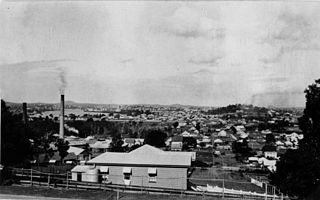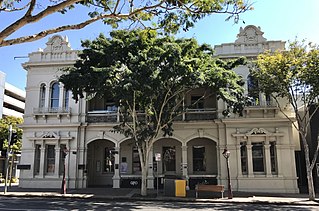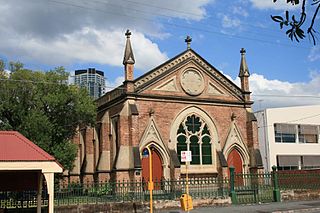
Albion is an inner north-eastern suburb in the City of Brisbane, Queensland, Australia. In the 2016 census, Albion had a population of 2,296 people.

The Hou Wang Temple is a heritage-listed former temple and now museum at Herberton Road, Atherton, Tablelands Region, Queensland, Australia. Built in 1903, it is one of the oldest original Chinese temples in Australasia. It is also known as Hou Wang Miau, Atherton Joss House and Atherton Chinese Temple.

The Breakfast Creek is a small urban stream that is a tributary of the Brisbane River, located in suburban Brisbane in the South East region of Queensland, Australia.

Breakfast Creek Hotel is a heritage-listed hotel at 2 Kingsford Smith Drive, Albion, City of Brisbane, Queensland, Australia. It was designed by Simkin & Ibler and built in 1889 to 1890 by Thomas Woollam & William Norman. It was added to the Queensland Heritage Register on 21 October 1992.

Brisbane School of Arts is a heritage-listed school of arts at 166 Ann Street, Brisbane City, City of Brisbane, Queensland, Australia. It was built from 1865 to 1985. It is also known as former Servants Home. It was added to the Queensland Heritage Register on 21 October 1992.

Old Bishopsbourne Chapel is a heritage-listed Anglican chapel at 233 Milton Road, Milton, City of Brisbane, Queensland, Australia. It was designed by Robin Dods and built in 1912 by Hall & Myers. It is also known as St Francis' Theological College Chapel and Chapel of the Holy Spirit. It was added to the Queensland Heritage Register on 21 October 1992.

Fortitude Valley Post Office is a heritage-listed former post office at 740 Ann Street, Fortitude Valley, City of Brisbane, Queensland, Australia. It was designed by Colonial Architect's Office and built in 1887 by William Ferguson. It is also known as Fortitude Valley Post & Telegraph Office. It was added to the Queensland Heritage Register on 24 January 2003.

St Patrick's Church is a heritage-listed Roman Catholic church at 58 Morgan Street, Fortitude Valley, City of Brisbane, Queensland, Australia. It was designed by Andrea Giovanni Stombuco and built from 1880 to 1882 by John Arthur Manis O'Keefe. It was added to the Queensland Heritage Register on 21 October 1992.

Holy Cross Laundry is a heritage-listed benevolent institution at 60 Bridge Street, Wooloowin, City of Brisbane, Queensland, Australia. It was designed by Francis Drummond Greville Stanley and built from 1888 to 1905. It was also known as Magdalen Asylum. It was added to the Queensland Heritage Register on 21 October 1992.

Oakwal is a heritage-listed villa at 50 Bush Street, Windsor, City of Brisbane, Queensland, Australia. It was designed by architect James Cowlishaw and built in 1864 by John Petrie with subsequent modifications to c. 1948. It was added to the Queensland Heritage Register on 14 May 1993.

Craigellachie is a heritage-listed detached house at 10 Fosbery Street, Windsor, City of Brisbane, Queensland, Australia. It was built c. 1889 by its owner John Grant, a stonemason. It was added to the Queensland Heritage Register on 21 October 1992.

Glenugie is a heritage-listed villa at 186 Moray Street, New Farm, City of Brisbane, Queensland, Australia. It was built from 1884 to 1885. It is also known as Archibald House. It was added to the Queensland Heritage Register on 21 October 1992.

Spring Hill Baths is a heritage-listed swimming pool at 14 Torrington Street, Spring Hill, City of Brisbane, Queensland, Australia. It was designed by Thomas Kirk and built from 1886 to 1913 by William M Park. It is also known as Arthur Street City Baths and Municipal Baths at Spring Hill. It was added to the Queensland Heritage Register on 21 October 1992.

St Paul's Presbyterian Church is a heritage-listed Presbyterian church at 43 St Pauls Terrace, Spring Hill, City of Brisbane, Queensland, Australia. It was designed by Francis Drummond Greville Stanley and built from 1887 to 1889 by Thomas Rees. It was added to the Queensland Heritage Register on 21 October 1992.

St Paul's Presbyterian Church Hall is a heritage-listed church hall at 43 St Pauls Terrace, Spring Hill, City of Brisbane, Queensland, Australia. It was designed by Francis Drummond Greville Stanley and built in 1886. It is also known as Sabbath School Hall. It was added to the Queensland Heritage Register on 21 October 1992.

St George's Masonic Centre is a heritage-listed masonic lodge at 50A Guy Street, Warwick, Southern Downs Region, Queensland, Australia. It was designed by William Wallace and built from 1886 to 1887. It was added to the Queensland Heritage Register on 21 October 1992.

The Sze Yup Temple is a heritage-listed Chinese joss house and Taoist temple located at Victoria Road in the inner western Sydney suburb of Glebe in the City of Sydney local government area of New South Wales, Australia. It was built from 1898 to 1904. Properly the Sze Yup Kwan Ti Temple, it is also sometimes called the Sze Yup Temple & Joss House or Joss House and Chinese Temple. The property is owned by Trustees of the Sze Yup Temple. It was added to the New South Wales State Heritage Register on 2 April 1999. It is one of only four pre-World War I Chinese temples that remain active in Australia.

Croydon Cemetery is a heritage-listed cemetery at Julia Creek Road, Croydon, Shire of Croydon, Queensland, Australia. It was opened c. 1889. It was added to the Queensland Heritage Register on 25 October 2002.

Chinese Temple and Settlement Site is a heritage-listed temple off Gulf Developmental Road, Croydon, Shire of Croydon, Queensland, Australia. It was built circa 1880s. It was added to the Queensland Heritage Register on 28 July 2000.

Yiu Ming Temple is a heritage-listed Chinese temple at 16–22 Retreat Street, Alexandria, City of Sydney, New South Wales, Australia. Built in 1908–1909, Yiu Ming Temple is one of the oldest surviving Chinese temples in Australia and a globally rare intact example of the traditional Chinese village temple form. While commonly known as the "Yiu Ming Temple", its formal name is Hong Sheng Gong or Hung Sheng Gong, which indicates that it is a Hung Shing Temple. It is also sometimes known as Yiu Ming Hung Fook Tong Temple(Chinese: 要明洪福堂), which is strictly the name of the previous temple used by the same community. It was added to the New South Wales State Heritage Register on 24 September 1999.


























